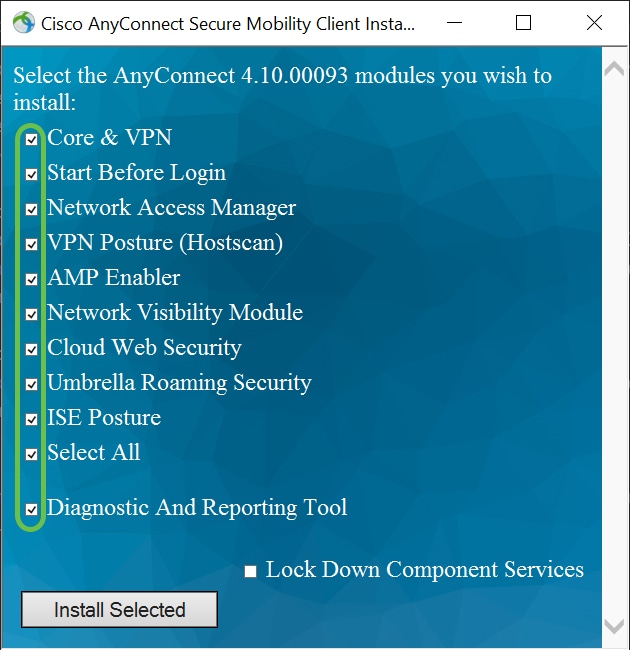- There are a number of Universal Windows Platform VPN applications, such as Pulse Secure, Cisco AnyConnect, F5 Access, Sonicwall Mobile Connect, and Check Point Capsule. If you want to use a UWP VPN plug-in, work with your vendor for any custom settings needed to configure your VPN solution. Configure connection type.
- Cisco AnyConnect Login (Windows 10) – Start Before Login 1. Press Ctrl+Alt+Delete to unlock the computer. After clicking OK at the next screen, click the Cisco AnyConnect icon located at the lower-right corner. Note: You must have an internet connection. The Cisco AnyConnect Secure Mobility client will appear.
Connecting to VPN with AnyConnect Navigate to Cisco AnyConnect Secure Mobility Client from the Start menu. All apps Cisco Cisco AnyConnect Secure Mobility Client Select your connection preference from the drop-down menu. Install VPN; Connect to VPN; Disconnect from VPN; Download these instructions as a PDF. Download the package. Locate the VPN installer you downloaded (anyconnect.exe) and double-click the exe to run the installer. Click the Next button to proceed.
-->Applies to
- Windows 10
- Windows 10 Mobile
Virtual private networks (VPNs) are point-to-point connections across a private or public network, such as the Internet. A VPN client uses special TCP/IP or UDP-based protocols, called tunneling protocols, to make a virtual call to a virtual port on a VPN server. In a typical VPN deployment, a client initiates a virtual point-to-point connection to a remote access server over the Internet. The remote access server answers the call, authenticates the caller, and transfers data between the VPN client and the organization’s private network.
There are many options for VPN clients. In Windows 10, the built-in plug-in and the Universal Windows Platform (UWP) VPN plug-in platform are built on top of the Windows VPN platform. This guide focuses on the Windows VPN platform clients and the features that can be configured.
Built-in VPN client
Tunneling protocols
Configure the IPsec/IKE tunnel cryptographic properties using the Cryptography Suite setting in the VPNv2 Configuration Service Provider (CSP).
L2TP with pre-shared key (PSK) authentication can be configured using the L2tpPsk setting in the VPNv2 CSP.
SSTP is supported for Windows desktop editions only. SSTP cannot be configured using mobile device management (MDM), but it is one of the protocols attempted in the Automatic option.
Note
When a VPN plug-in is used, the adapter will be listed as an SSTP adapter, even though the VPN protocol used is the plug-in's protocol.
Automatic
The Automatic option means that the device will try each of the built-in tunneling protocols until one succeeds. It will attempt from most secure to least secure.
Configure Automatic for the NativeProtocolType setting in the VPNv2 CSP.
Universal Windows Platform VPN plug-in
The Universal Windows Platform (UWP) VPN plug-ins were introduced in Windows 10, although there were originally separate versions available for the Windows 8.1 Mobile and Windows 8.1 PC platforms. Using the UWP platform, third-party VPN providers can create app-containerized plug-ins using WinRT APIs, eliminating the complexity and problems often associated with writing to system-level drivers.
There are a number of Universal Windows Platform VPN applications, such as Pulse Secure, Cisco AnyConnect, F5 Access, Sonicwall Mobile Connect, and Check Point Capsule. If you want to use a UWP VPN plug-in, work with your vendor for any custom settings needed to configure your VPN solution.

Configure connection type
See VPN profile options and VPNv2 CSP for XML configuration.
The following image shows connection options in a VPN Profile configuration policy using Microsoft Intune:
In Intune, you can also include custom XML for third-party plug-in profiles:
Related topics
Installing the VPN Client
- Download the AnyConnect VPN client for Windows. Note: If you're using Microsoft Edge, the program will download as a 'sys_attachment.do' file. You will need to rename the file to 'sys_attachment.msi'
- If you have the Windows Surface Pro X tablet with an ARM-based processor, you should download the AnyConnect VPN client for ARM64.
- Click Run on the Open File – Security Warning dialog box.
- Click Next in the Cisco AnyConnect Secure Mobility Client Setup dialog box, then follow the steps to complete the installation. NOTE: We recommend you un-check everything (Web Security, Umbrella, etc) except for the VPN and the Diagnostic and Reporting Tool (DART). This will give you a minimal install. The other features are not supported so there's no need to install them.
Starting the VPN Client
- Go to Start->Programs->Cisco->Cisco AnyConnect Secure Mobility Client to launch the program.
- Enter vpn.uci.edu in the Ready toConnect to field, then press the Connect button.
- Select your desired connection profile from the Group drop-down menu:
- UCIFULL – Route all traffic through the UCI VPN.
- IMPORTANT: Use UCIFULL when accessing Library resources.
- UCI – Route only campus traffic through the UCI VPN. All other traffic goes through your normal Internet provider.
- UCIFULL – Route all traffic through the UCI VPN.
- Enter your UCInetID and password, then click OK.
- A banner window will appear. Click Accept to close that window. You are now connected!
Cisco Anyconnect Vpn Windows 10 Login
Disconnecting the VPN Client
When you are finished using the VPN, remember to disconnect.

Cisco Anyconnect Vpn Windows 10
- Right-click the AnyConnect client icon located in the system tray near the bottom right corner of your screen.
- Select Quit.
